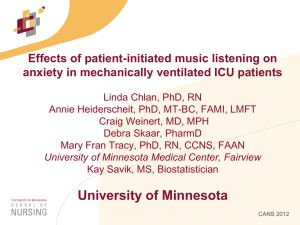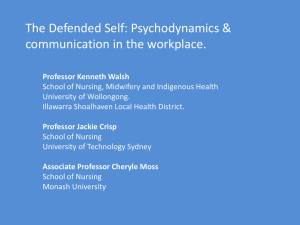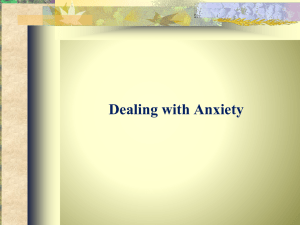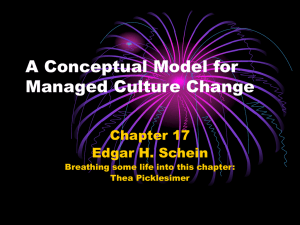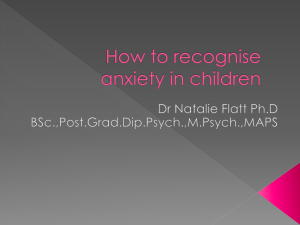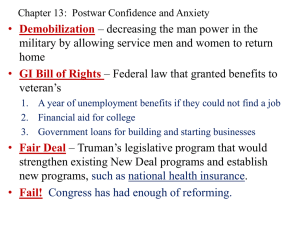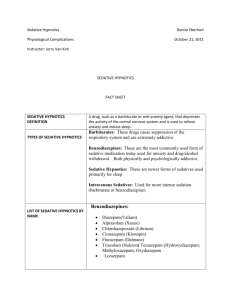Anxiety - Music and Wellness
advertisement
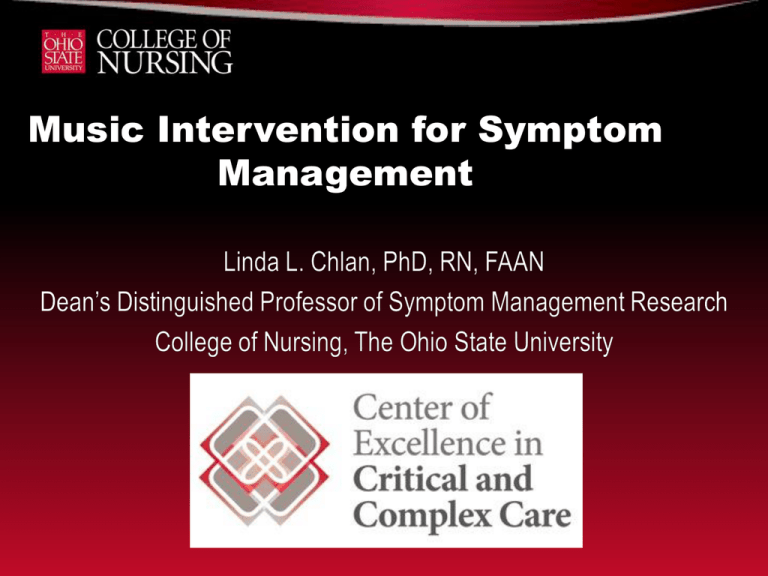
Music Intervention for Symptom Management Presentation Overview • Scientific basis of music for anxiety reduction • Importance of music preference assessment for music listening interventions • Music intervention research for symptom management in critically ill patients receiving mechanical ventilatory support – Exemplar of a program of research testing an integrative therapy – Multidisciplinary team What are Symptoms? • Departure from normal function or feeling which is noticed by a patient, potentially indicating the presence of disease or abnormality; acute, chronic, wax/wane, resolve • Subjective & observed by the patient; self-reported • Can be specific (pain) or non-specific symptoms • Can be acute or chronic, associated with medical conditions, whether physical or mental, and may be either a primary or secondary symptom – Fatigue – Anxiety – Pain BACKGROUND •Approximately 5 million patients receive mechanical ventilatory support yearly in the U.S. •55,000 adults admitted daily to ICUs in the U.S. •Commonly used ICU supportive modality •34% require ventilatory support for > 48 hours; increasing •ICUs are inherently stressful for patients and family •Distress from noise, lack of sleep, social isolation, frustration, etc. Patient Symptom Reports • 10-item checklist physical and psychological symptoms (pain, tired, short of breath, restless, anxious, sad, hungry, scared, thirsty, confused) • Presence (yes/no), intensity (1/mild, 2/moderate, 3/severe), distress (1/not very distressing, 2/moderate, 3/very distressing) • 34% mechanically ventilated in two ICUs – – – – Anxiety, thirsty, tired reported by 50-75% of assessments No difference in intensity or distress if MV, except anxiety Pain: mild-moderate intensity; mod-severe distress Dyspnea was most distressing Puntillo KA, Shoshana A, Cohen N, Gropper M. et al. Symptoms experienced by intensive care unit patients at high risk of dying. Crit Care Med 2010; 38:2155-2160. Patient Responses to Mechanical Ventilatory Support • Physiological Stress Stress of critical illness or infection + Delivery of mechanical breaths • Critical illness or injury • Lung injury • Ventilator associated pneumonia • Psychological stress – Anxiety: a heightened state of arousal – Fear – Feel miserable – Inability to speak; cannot convey needs, feelings, etc. Anxiety Ratings in Mechanically Ventilated Patients • Common bothersome symptom • Cross-sectional ratings; importance of descriptive research • State Anxiety Inventory (score range 20-80) – < 5 days 48.6 + 12.0 – 6-21 days 50.2 + 12.5 – 22+ days 54.2 +11.9 – Chronic/long-term 45.8 +14.5 Chlan L. Description of anxiety levels by individual differences and clinical factor in patients receiving mechanical ventilatory support. Heart Lung 2003; 32:275-282. Individual Anxiety Plots Anxiety Ratings in Mechanically Ventilated Patients • Previous work limited to cross-sectional ratings • State Anxiety Inventory (score range 20-80) – < 5 days 48.6 + 12.0 – 6-21 days 50.2 + 12.5 – 22+ days 54.2 +11.9 – Chronic/long-term 45.8 +14.5 Chlan L. Description of anxiety levels by individual differences and clinical factor in patients receiving mechanical ventilatory support. Heart Lung 2003; 32:275-282. SUSTAINED ANXIETY Physiological responses: – SNS stimulation; CV responses; increased WOB and oxygen demand; myocardial stimulation Psychological responses: – Fear, inability to focus, inability to relax or sleep • Usual treatment for anxiety is sedative medications • Limitations and adverse side effects Adjunctive Interventions • Sedative agents are warranted at times yet induce significant and numerous adverse effects • Safe and scientifically sound interventions are needed • Does not induce adverse effects • Can a non-pharmacologic, adjunctive intervention (music) reduce anxiety and sedative exposure over the course of mechanical ventilatory support? • • • • • Why Music? Scientific Basis of Music to Reduce Stress Music perceived as familiar and soothing occupies the brain Interrupts the stress response – facilitates relaxation Focuses attention on pleasing stimuli of music – reduces anxiety Music can be a powerful distractor Reduces amount of sedative medications during medical procedures (colonoscopy, ambulatory surgery) Scientific Basis of Music to Reduce Stress: SR Interruption • Reception of music produces neural impulses that dampen the arousability of the CNS through inhibitory neurotransmitters • Withdrawal of sympathetic activity through diminished norepinephrine release • Induces relaxation – Diminished SNS activity – Increased PNS activity What is Relaxing Music? • • • • • • Tempo at or below resting heart rate (< 80 bpm) Predictable dynamics Fluid, melodic movement Pleasing harmonies Regular rhythm without sudden changes Soft tones – Strings, flute, piano, or specially synthesized Anxiety Reduction Through Music Intervention • Steady, slow, repetitive rhythms exert a “hypnotic” effect • Cognitive quieting • Altered states of consciousness alter perceived anxiety and facilitate more relaxed states • Music perceived as pleasant and relaxing reduces tension as relaxation is incompatible with anxiety Music for Distraction • Preferred music can be a powerful distractor • Provides an alternative focus to a more pleasing, comforting stimulus, rather than focusing on stressful environmental stimuli or thoughts. • Important to assess music preferences, familiarity, cultural context Psychophysiologic responses of mechanically ventilated patients to music: A pilot study Chlan L. Am Jl Crit Care 1995; 4: 233-238 • Randomized n = 20 mechanically ventilated patients – 30 min. music listening or resting quietly with headphones – Pre-post design with repeated measures • Music intervention consisted of MusicRx choices (Dr. Helen Bonny); all classical music • Generalized relaxation response – Decreased HR, RR; BP trended downward • Reduced distress associated with illness Effectiveness of music therapy intervention on relaxation and anxiety for patients receiving ventilatory assistance. Chlan L. Heart Lung1998; 27: 169-76 • Randomized n = 56 mechanically ventilated patients – 30 min. music listening or resting quietly – Pre-post design with repeated measures • Music intervention consisted of variety of instrumental music; choice • Significant state anxiety reduction after music – Decreased HR & RR • Participants desired to listen to music throughout the time in the ICU; asking for names of music choices Investigating the feasibility of a music intervention protocol with patients receiving mechanical ventilatory support. Chlan L. Alt Therapies Health Med 2001; 7: 80-83 • N = 6 mechanically ventilated patients (feasibility) • Aim was to determine if ventilated patients can and will initiate music listening (descriptive research) • Music intervention consisted of a wide variety of music genres guided by assessment • Patients did initiate music listening; equipment • Requires wide variety of music and knowledge of music to accommodate personal preferences Influence of music on the stress response in patients receiving mechanical ventilatory support: A pilot study. Chlan L. Am Jl Crit Care 2007; 16: 139-143 • N = 10 mechanically ventilated patients – Randomized to 60 min. of relaxing music or resting quietly • Aim was to determine if music could alter select indicators of the stress response (SR) – E, NE, ACTH, cortisol • Interruptions during protocol • Serum is problematic to obtain; sampling, stability • Trends toward decreased ACTH & cortisol in music subjects; slight increase in rest group Reducing Sedative Exposure in Ventilated ICU Patients • Primary Aims: To determine if patient-directed music (PDM) reduces anxiety and sedative exposure over the course of ventilatory support R01 NR009295 NCT00440700 DESIGN • Three-group randomized clinical trial • Remained on protocol as long as mechanically ventilated, up to 30 days • Subjects randomized to: – 1) Patient-directed music listening (experimental) • Preferred, relaxing music; tailored music collection • Assessment of music preferences daily by music therapist • Allows choice, control, and self-management of anxiety – 2) Noise-canceling headphones (active control) – 3) Usual care (control) – No formal sedation protocols in place Sedative Exposure • • • • Daily Sedation Intensity Score Daily Sedation Frequency Accounts for sedative medications from disparate drug classes Aggregate data from all patients on 8 commonly received medications Weinert C, Calvin A. Epidemiology of sedation and sedation adequacy for mechanically ventilated patients in a medical and surgical intensive care unit. Crit Care Med. 2007; 35(2):393-401. SETTING and SAMPLE • 5 medical centers in the Minneapolis-St. Paul urban area • 12 ICUs total (medical, medical-surgical) • Adult critically ill patients receiving acute mechanical ventilatory support for a primary pulmonary component • Pneumonia, COPD, respiratory failure, pulmonary edema, etc. • Alert and interacting appropriately with nursing staff • Provide own informed consent • IRB and intervention requirements MEASURES • Anxiety • 100-mm Visual Analog Scale-Anxiety • Illness severity (APACHE III) • Length of time mechanically ventilated • Length of ICU stay • All daily medications • Music Assessment Tool (experimental) Patient Characteristics N = 373 enrolled; 52% female Age = 58.5 +14.4; Range 21-88 86% White, 12% Black, 1%Native American, 1%Asian APACHE III 63.2 + 21.6; Range 15-123 55% respiratory failure, 25% respiratory distress, 5% pneumonia, 3% COPD, 2% hypoxemia, 10% other • Median total ICU days = 17 (1-86) • Median total ventilator days = 10 (0-80) • • • • • RESULTS • Baseline anxiety 48.8 + 29.3; range 0-100 • Moderate anxiety • Highly variable and individual symptom • PDM patients listened to music 79.8 minutes/day – Wide variety of preferred music • Headphones patients wore them for 34 minutes/day • 5.7 + 6.4 days on protocol; Range 1-30 days Primary Analysis • Change by assigned group first assessed using scatterplots • Mixed-effects models • Change over time & deals with missing data • Series of best fitting models accounting for covariates of interest (illness severity, age, gender, time, baseline anxiety, sedative exposure) • Included data on subjects with 2 or more data points to model change over time RESULTS • Please refer to the original publication for detailed model parameters and results (Chlan L., et al., JAMA June 2013) Discussion of Results • Participants self-initiated music listening when desired • Individual control and management of highly variable symptom • PDM significantly reduced anxiety and sedative exposure during mechanical ventilatory support; compared to usual care • No difference between HPs and usual care • PDM patients had symptom reduction along with reduced sedative exposure • Anxiety -19.5 points; reduced 36.5% by 5th study day • Sedation intensity reduced 36% by 5th study day • Sedation frequency reduced 38% by 5th study day – Significantly less than HPs and Usual care Implications for Practice and Future Research • Beneficial, effective adjunctive intervention for anxiety • No documented adverse effects • Integrate appropriately into ICU care • Self-directed and preferred music allows for choice and control; empowers patients • Impact of PDM on other outcomes warrant future research • Ventilator-free days? • Cost? • Influence on post-ICU outcomes is unknown


